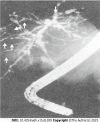Liver transplant in primary sclerosing cholangitis: Current trends and future directions
- PMID: 37701917
- PMCID: PMC10494561
- DOI: 10.4254/wjh.v15.i8.939
Liver transplant in primary sclerosing cholangitis: Current trends and future directions
Abstract
Primary sclerosing cholangitis (PSC) is a chronic and progressive immune-mediated cholangiopathy causing biliary tree inflammation and scarring, leading to liver cirrhosis and end-stage liver disease. Diagnosis of PSC is challenging due to its nonspecific symptoms and overlap with other liver diseases. Despite the rising incidence of PSC, there is no proven medical therapy that can alter the natural history of the disease. While liver transplantation (LT) is the most effective approach for managing advanced liver disease caused by PSC, post-transplantation recurrence of PSC remains a challenge. Therefore, ongoing research aims to develop better therapies for PSC, and continued efforts are necessary to improve outcomes for patients with PSC. This article provides an overview of PSC's pathogenesis, clinical presentation, and management options, including LT trends and future aspects. It also highlights the need for improved therapeutic options and ethical considerations in providing equitable access to LT for patients with PSC. Additionally, the impact of liver transplant on the quality of life and psychological outcomes of patients with PSC is discussed. Ongoing research into PSC's pathogenesis and post-transplant recurrence is crucial for improved understanding of the disease and more effective treatment options.
Keywords: Liver transplantation; Management; Pathogenesis; Primary sclerosing cholangitis; Psychosocial outcomes.
©The Author(s) 2023. Published by Baishideng Publishing Group Inc. All rights reserved.
Conflict of interest statement
Conflict-of-interest statement: Authors declare no conflict of interests for this article.
Figures


Similar articles
-
Inflammatory conditions play a role in recurrence of PSC after liver transplantation: An international multicentre study.JHEP Rep. 2022 Oct 1;4(12):100599. doi: 10.1016/j.jhepr.2022.100599. eCollection 2022 Dec. JHEP Rep. 2022. PMID: 36426376 Free PMC article.
-
Timing, Management, and Outcomes of Liver Transplantation in Primary Sclerosing Cholangitis.Semin Liver Dis. 2017 Nov;37(4):305-313. doi: 10.1055/s-0037-1608655. Epub 2017 Dec 22. Semin Liver Dis. 2017. PMID: 29272893 Review.
-
Interferon-γ-dependent immune responses contribute to the pathogenesis of sclerosing cholangitis in mice.J Hepatol. 2019 Oct;71(4):773-782. doi: 10.1016/j.jhep.2019.05.023. Epub 2019 Jun 5. J Hepatol. 2019. PMID: 31173810
-
Clinical outcomes of donation after circulatory death liver transplantation in primary sclerosing cholangitis.J Hepatol. 2017 Nov;67(5):957-965. doi: 10.1016/j.jhep.2017.06.027. Epub 2017 Jul 8. J Hepatol. 2017. PMID: 28690174
-
Metal, magnet or transplant: options in primary sclerosing cholangitis with stricture.Hepatol Int. 2018 Nov;12(6):510-519. doi: 10.1007/s12072-018-9906-6. Epub 2018 Nov 14. Hepatol Int. 2018. PMID: 30430358 Review.
Cited by
-
Colorectal Cancer Screening and Management in Low- and Middle-Income Countries and High-Income Countries: A Narrative Review.Cureus. 2024 Oct 6;16(10):e70933. doi: 10.7759/cureus.70933. eCollection 2024 Oct. Cureus. 2024. PMID: 39502970 Free PMC article. Review.
-
The Role of Microbiome in Cardiovascular Health: Insights for Primary Care Interventions.Cureus. 2024 Sep 27;16(9):e70311. doi: 10.7759/cureus.70311. eCollection 2024 Sep. Cureus. 2024. PMID: 39463572 Free PMC article. Review.
-
Comparative Outcomes of Minimally Invasive Versus Open Pancreatoduodenectomy in Distal Cholangiocarcinoma: A Systematic Review and Meta-Analysis.Cureus. 2024 Apr 30;16(4):e59404. doi: 10.7759/cureus.59404. eCollection 2024 Apr. Cureus. 2024. PMID: 38817514 Free PMC article. Review.
-
Exploring Aspirin's Potential in Cancer Prevention: A Comprehensive Review of the Current Evidence.Cureus. 2024 Sep 23;16(9):e70005. doi: 10.7759/cureus.70005. eCollection 2024 Sep. Cureus. 2024. PMID: 39445288 Free PMC article. Review.
-
Assessment of morbidity and mortality after liver transplantation for primary sclerosing cholangitis.Hepatobiliary Surg Nutr. 2024 Feb 1;13(1):154-156. doi: 10.21037/hbsn-23-599. Epub 2024 Jan 12. Hepatobiliary Surg Nutr. 2024. PMID: 38322220 Free PMC article. No abstract available.
References
-
- Mehta TI, Weissman S, Fung BM, Sotiriadis J, Lindor KD, Tabibian JH. Global incidence, prevalence and features of primary sclerosing cholangitis: A systematic review and meta-analysis. Liver Int. 2021;41:2418–2426. - PubMed
-
- Karlsen TH, Folseraas T, Thorburn D, Vesterhus M. Primary sclerosing cholangitis - a comprehensive review. J Hepatol. 2017;67:1298–1323. - PubMed
Publication types
LinkOut - more resources
Full Text Sources

